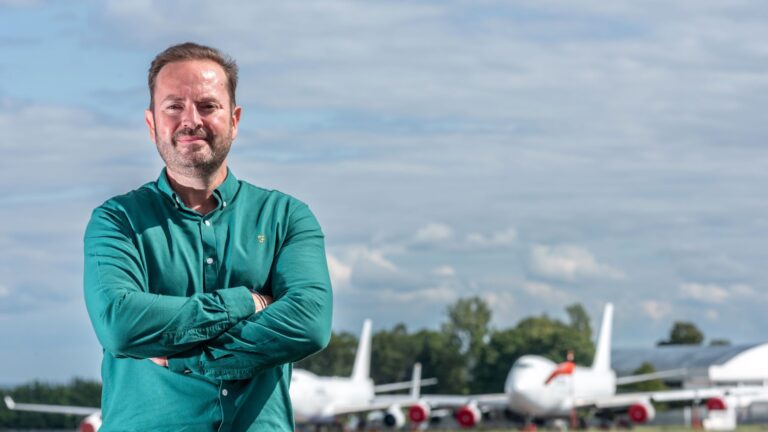
With demand for SAF high on the agenda in a rapidly transforming energy sector, Claudia Weeks, Community Content Lead for Fuel Oil News, met with James Hygate, CEO, for an update on the business since our original interview back in March 2023.
Firefly Green Fuels
The biofuel industry continues to move rapidly and, with everyone working to progress at pace, Fuel Oil News caught up with James to find out what has been achieved in the last year and what the future is looking like for sustainable aviation.
James is the founder and CEO of Firefly Green Fuels, which makes sustainable aviation fuel out of sewage. Firefly has gained £5m in funding and an offtake agreement for up to 525,000 tonnes of fuel from ultra-low-cost airline Wizz Air.
A serial entrepreneur, James is also the founder of Green Fuels which, over a period of 20 years, has pioneered waste to biofuel technology. Green Fuels has helped its customers reduce their carbon emissions by an estimated 6.5 million tonnes.
The biofuels industry
“I have been working in the biofuels space for over two decades now, and during that time I have witnessed remarkable changes in how this industry is viewed, both by the public at large, and by industries waking up to the reality of climate change and how a warming earth will affect their bottom line.” James began, explaining the current industry perception of biofuels.
“In my lifetime alone, biofuels have gone from a somewhat fringe industry to being viewed as a serious energy alternative for our fuel hungry world. I have also been truly fortunate that my company, Green Fuels, has been at the forefront of that shift, producing biorefineries and equipment that has saved millions of tonnes of carbon for our customers all over the globe.
“With Green Fuels, we were able to make a significant impact in the road fuels space, but for the past several years our sights have been set higher than that, up in the skies you might say! We decided that it made most sense to focus on abating the more difficult to decarbonise sectors – the future of road travel is clearly in electrification and when we have sufficient renewable energy – hydrogen. However, the simple fact is that neither batteries nor hydrogen are energy dense enough to support long-haul travel.”
The future for Sustainable Aviation Fuel
Looking at the challenge of decarbonising the aviation industry, James continues: “We have known for a while that what we need in aviation is a drop-in replacement that comes from a sustainable source and that can be produced at high volumes. Indeed, there are already a lot of other fantastic companies working in this space.”
“Some of these companies are further along than we are and are using different, established feedstocks and pathways. The problem that exists right across the SAF industry, however, is that most waste feedstocks are already ringfenced for one use or another.”
“Some pathways to SAF are competing for feedstock, other feedstocks have uses outside of SAF; there is simply not enough to go around. This has been a major limiting factor for the whole industry and it’s the reason why we started to research into the viability of sewage sludge.”
The importance of feedstock
The issue of feedstock availability for biofuels is very much a current industry talking point. On top of the scarcity issue, businesses must ensure the provenance of feedstocks is truthful and that their production is not creating additional environmental issues.
James reflects: “There is a huge amount of untapped potential in sewage. It’s a low cost, completely biogenic material. Right now, it holds little value. In fact, it’s currently viewed as a problem waste, the disposal of which poses a constant challenge to municipalities around the globe. When we first started, we suspected this was the case, but now we know it for a fact as we are approached practically every week by different councils and governments who are all waiting on tenterhooks for our technology to become commercially available to them!
“During our research we could also see that this already highly abundant feedstock is one that will only increase in volume year on year in line with global population growth. Plus, when we investigated how it is currently managed, we realised that all current disposal routes are extremely suboptimal. In the UK, processed sewage sludge is taken and spread onto land as a fertiliser – a practice already banned in several countries, and which is likely to soon be outlawed here due to known complications including agricultural runoff.
“The only other disposal route for sewage currently available is incineration, an energy intensive and relatively costly process due to the high-water content of the sludge. We could see that there was real opportunity for somebody like us to come in and solve problems at both ends of the value chain, helping to dispose of low value unwanted waste by converting it into high value sustainable fuel.”
Perfecting the process
“For the past few years, we have been perfecting our process and we are now approaching a stage where we are ready to start commercialising which is really exciting. So far, all the testing carried out on our fuel has been extremely positive. In 2022 Cranfield University carried out an independent lifecycle analysis on our fuel which showed it to have a 92% CO2e saving versus fossil jet fuel. That’s incredibly significant.”
James added: “I really believe that sewage sludge is going to be a huge part of the equation when it comes to global SAF production, the processes that we use are quite straightforward and that’s really the key when it comes to an efficient scale up. Simplicity in our process means that we can scale up fast and de-risks the process significantly – when there are less unknowns, it gives us confidence that we will be able to roll this technology out all around the world.”
The challenges of producing SAF at volume.
“When looking at the volumes of SAF required between now and 2050 the numbers are astronomically huge. We really do need every different technology and pathway to SAF to work at maximum capacity if we want to reach net zero and abate climate disaster.
“As I see it, there are three main challenges that all SAF producers face to reach production at a significant scale:
Challenge 1 – feedstock
“The first challenge is an obvious one, but finding a sustainable feedstock in sufficient volumes can be a real challenge. I alluded to this above, but unless this can be addressed, the SAF market won’t be sustainable in the long term.
“This is where Firefly stands alone in the SAF market right now, we have identified a feedstock that is non-competing, and which is produced in every country around the world on a daily basis.
Challenge 2 – price
“The second challenge is in understanding whether the route can ever be financially viable. By this, what I mean is if you are starting at a production point that’s ten times the price of fossil fuels, selling that fuel on to airlines is going to be a very hard sell, especially when you are competing with other pathways producing fuel at a much more competitive rate. At the end of the day airlines will have to pass on these costs to their consumers.
Challenge 3 – financing
“The third major challenge facing all SAF producers is financing a first of a kind facility (FOAK). These first facilities are incredibly expensive and need to be financed via infrastructure funds and debt. To even consider raising money for a FOAK facility, producers need to have solid offtake agreements, as well as price support mechanisms and mandates in place.
“At Firefly we are extremely pleased with the relationship we have developed with Wizz Air, they fully understood this need and worked with us to provide a ‘bankable’ offtake for 525,000 tonnes. This offtake alone is going to save 2.5m tonnes of CO2e, alongside helping us fund the FOAK facility.
The key to accelerating commercially viable production
“The most important thing we need in the UK is a mandate, this is something that has been consulted on, but is yet to be in place, at the time of writing.
“There is a colossal opportunity for the UK to develop a domestic SAF industry, we are leaders in aviation and have been for over 100 years, but without a mandate in place commercial facilities simply will not get financed and will subsequently be built elsewhere where mandates are already in place.”
A positive impact on the UK economy
James is passionate about the economic impact that producing SAF could have for this country: “I cannot overstate the impact that this burgeoning industry could have on the UK economy. SAF production needs to grow by a factor of 1,600 over the coming decades if we are to meet net zero. That means job opportunities, it means economic growth, and, ultimately, it means moving the needle on our climate impact in the right direction.
“To meet current targets, we will also need as many different production routes to be operational as possible. We will also need to see the transition of biofuels from road use to aviation.
“This is a unique and interesting industry to be a part of – SAF developers are incredibly supportive of each other because there is a broad understanding that we are all working to achieve the same goal. Importantly, there is also a huge level of demand for SAF meaning that the playing field is large enough for us all to flourish at scale without stepping on each other’s toes.”
Hope for the future?
Looking to the future, James concludes: “Where there is a challenge there is an opportunity; this is where we see new routes to SAF, such as ours, developing. Sewage offers a phenomenal opportunity in the UK, where the waste we produce each day could meet half the 2030 SAF target.
“The numbers get very exciting when you look at very populous cities, such as Mumbai, where the sewage created by the city’s 25 million residents has the potential to fuel 80% of the needs of Mumbai International.
“The fact of the matter is that, for change to occur, we need economically viable green alternatives. Firefly’s route to SAF will use the many advantages that sewage offers, compared to other feedstocks, to produce a cost-effective SAF that will effectively turn waste material into profit.
“We will achieve this whilst also helping to promote public health and biodiversity in areas where sewage is currently discharged, as well as providing a pathway towards economic independence for resource poor communities through processing their waste into biocrude. We are incredibly hopeful for the future, and we are greatly encouraged to see many other innovative companies like ours rising to the challenge of climate change.”
James and the team at Firefly Green Fuels have a clear strategy for establishing the pathway towards a greener future for aviation. Fuel Oil News looks forward to following their journey.


